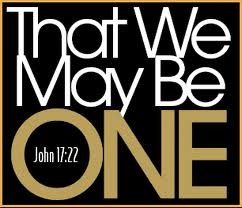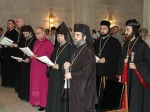A Look at Kent Hunter’s “The Future Is Now: How God Is Moving In The 21st Century Church

 I came across an ebook by Kent R. Hunter of Church Doctor Ministries entitled “The Future Is Now: How God Is Moving In The 21st Century Church.” I would like to quote from this source since it is so good, and then add a few of my analysis to it.
I came across an ebook by Kent R. Hunter of Church Doctor Ministries entitled “The Future Is Now: How God Is Moving In The 21st Century Church.” I would like to quote from this source since it is so good, and then add a few of my analysis to it.
From Chapter 16 – Snapshots of Tomorrow Today, Hunter says: “Another characteristic of the church in the 21st century will be a different form of ecumenism. The old ecumenism tried (and failed) in the modern era. It was a move for churches to get together under one banner, one structure, one belief system on every detail — homogenize together to show unity. On the mission field, something very different occurs. When you visit a remote outpost of mission, like the Kalahari Desert in Botswana; or Almaty, Kazakhstan (in the far reaches of the former Soviet Union near the western border of China), the missionaries you meet work together toward the common goals of the Kingdom. They are Kingdom people first, but they respect their denominational distinctives. They work together and cooperate, yet retain unique distinctives, where they honestly disagree on the interpretation of Scripture. They recognize what I call bottom-line theology.”
 During the 20th century, I thought ecumenism as a joke. I looked at the Council of Churches more as a political organization than I did a religious association. Those involved with ecumenism always talked about “dialoguing” about their differences, but nothing ever happened with the dialogues. The pages of the local Yellow Book phone book still has multiple sections under religion.
During the 20th century, I thought ecumenism as a joke. I looked at the Council of Churches more as a political organization than I did a religious association. Those involved with ecumenism always talked about “dialoguing” about their differences, but nothing ever happened with the dialogues. The pages of the local Yellow Book phone book still has multiple sections under religion.
The 21st century features dialoguing in the form of texts, tweets, emails, blogs, and Skyping, alias social networking. People are talking with one another not caring what “religious” label one has. In fact in the Information section of Facebook, most people put “Christian” rather than Presbyterian, Methodist, Lutheran, Baptist, etc. like their parents would have done in the last century.
 I, too, use to believe that ecumenism meant one banner, one structure, and one belief system. I have come to realize that the very diversity in the body of Christ that divided it is also its strength when the Church allows the Holy Spirit to work in it. In the outdoor Jesus Rallies held in Pennsylvania in the ‘70’s, and attending a Spirit Renewal Conference in the Super Dome in New Orleans in the late ‘80’s, I had a taste of immersion in the Body of Christ where we fellowshipped and worshipped together not knowing or caring what religious labels we carried. The Church is united when their only focus is on Jesus Christ.
I, too, use to believe that ecumenism meant one banner, one structure, and one belief system. I have come to realize that the very diversity in the body of Christ that divided it is also its strength when the Church allows the Holy Spirit to work in it. In the outdoor Jesus Rallies held in Pennsylvania in the ‘70’s, and attending a Spirit Renewal Conference in the Super Dome in New Orleans in the late ‘80’s, I had a taste of immersion in the Body of Christ where we fellowshipped and worshipped together not knowing or caring what religious labels we carried. The Church is united when their only focus is on Jesus Christ.
Diversity is actually the Church’s strength because it then transcends culture and traditions. The Church in Africa may express their musical form, language, and worship style differently than the Church in Europe or North America, but there is unity in worshiping Jesus Christ.
If being “in Jesus” is a unifying factor, then the five fold may be a structure allowing individual diversity with unifying results. Ephesians 4:12 states the purpose of the five fold is"to prepare God’s people for works of service, so that the body of Christ may be built up until we all reach unity in the faith and in the knowledge of the Son of God and become mature, attaining to the whole measure of the fullness of Christ.” The five fold is to help believers, the priesthood of believers, to “grow up”, become “mature” in “the fullness of Christ.” Christians who know who Jesus is and who they are in Jesus, being Christ-like, will naturally reach unity in faith. There is unity because of their Christ-likeness.
Even though the evangelist births, the pastoral shepherd nurtures, the teacher remains Biblically sound, the prophet seeks communion with God, and the apostles “sees over” all that the Holy Spirit is doing, it still remains that the Holy Spirit is doing it. If the Holy Spirit has liberty to move among each of them as he wills, diversity will remain in the body. We will not have “replica bobble-head dolls” of Christians. The Holy Spirit will move as needed as He wills in each congregation for the purpose of edifying Jesus and drawing men toward Jesus. As individual churches, bodies of Christ, develop into the fullness of Jesus, they will naturally draw to one another.
 I remember being in a Mennonite Renewal Meeting once when a prophetic word was given telling everyone there that “there will be a time when the only place you can find Mennonites is in a history book.” It took the prophet guts to give that word when in the midst of Mennonites, but he was “right on”. There will be a time “here on earth as it is in heaven” when the labels that divided the Church will be history and the Church will be united, prepared for the return of the Groom for His Bride.
I remember being in a Mennonite Renewal Meeting once when a prophetic word was given telling everyone there that “there will be a time when the only place you can find Mennonites is in a history book.” It took the prophet guts to give that word when in the midst of Mennonites, but he was “right on”. There will be a time “here on earth as it is in heaven” when the labels that divided the Church will be history and the Church will be united, prepared for the return of the Groom for His Bride.
I believe the 21st Century Church may see a greater form of unity in the Church than it has in centuries because of the movement of the Holy Spirit of Jesus Christ drawing His believers closer to Him. It will take time, but the diversity in the body of Christ just may prove to be the unifier of the 21st Century Church where it has been the divider in the past. Only the Holy Spirit can bring unity in the Church. Again, I ask, “Are you willing to trust the Holy Spirit?”